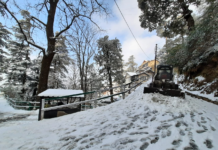Cloudbursts have become increasingly common in India. In recent times, Himachal Pradesh, Jammu and Kashmir, Ladakh and Uttarakhand, and the Western Ghats have witnessed cases of cloudbursts.
These not only claim lives, but also cause widespread devastation.
We explain what they are, why they cause so much destruction and the potential causes behind the increase in the frequency of cloudbursts.

Increased Cloudbursts
First, let’s decode what cloudbursts really are. A cloudburst is a sudden aggressive rainstorm falling for a short period of time, limited to a small geographical area. Its fall rate is equal to or greater than 100 mm per hour.
When Do They Occur?
They occur when warm monsoon winds interact with cold winds, leading to the formation of huge clouds, which is also due to the topography or orographic factors. Such clouds can stretch to even 13-14 kilometers in height. If they are trapped over a region or there is no air movement for them to disperse, they discharge over a specific area.
Cloudbursts often lead to flash floods, they claim several lives and even trigger landslides that sweep away everything in their way.
Why Are Cloudbursts So Dangerous?
Because of the amount of rain involved, a cloudburst can be quite dangerous, especially if it lasts for several hours. Topographical conditions like steep hills favour the formation of clouds. Water flowing down steep slopes brings debris, boulders, and uprooted trees with great velocity damaging any structure that comes in their way.
Additionally, cloudbursts are extremely hard to predict, which makes them all the more dangerous.
Why are Cloudbursts Hard To Predict?
Unlike cyclones, forecasting a cloudburst is very difficult due to the dynamics of the rapidly developing clouds over a very small area, the IMD has maintained.
There is no satisfactory technique for anticipating cloud bursts because of their small scale. A very fine network of radars is required to be able to detect the likelihood of a cloud burst and that would be prohibitively expensive.
In recent times, reports of cloudbursts have become increasingly frequent.
Are Cloudbursts Becoming More Frequent?
The IMD doesn’t have a separate database for cloudburst events. However, after analysis of observed trends from media reports and data on heavy and extremely heavy rainfall events, it maintains that there has been a sharp increase in cloudburst incidents in the past few years.
Experts say that global warming and climate change could be the leading reasons behind the increase in cloudbursts. Air temperature is one degree higher due to global warming, and warm air can hold more moisture, leading to cloudbursts.
Increased human activity on these terrains, also has an effect on the overall devastation that cloudbursts cause. Overcrowding of people, and construction on loose soil, make areas more prone to landslides and natural disasters. The natural flow of rivers is often obstructed, resulting in the overflowing of channels and which triggers erosion and subsequent silting up in the rivers.
With unmitigated human intervention continuing, and global warming on the rise, one must only always be prepared for natural calamities only getting deadlier in the coming days.





















